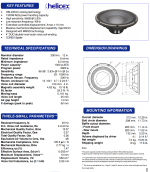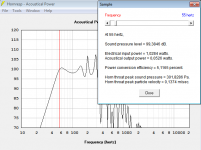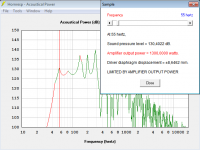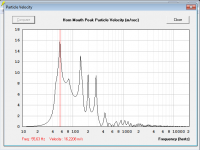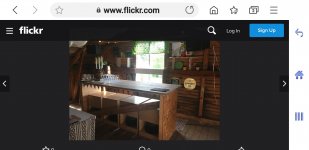Your box is smaller than my model, 162L vs 179L.
The mouth is almost 2 x Sd (531cm2).
I tried to keep the box small with low bass extension. The enclosure could probably fit in 90% of all trunks.
I used S1 and S4 from your model as a guide. The smaller box means that Fb is a bit higher (around 40 Hz).
I messed up big time rushing the excel spreadsheet while trying to finish up work by 5pm.
Horn length = 304.80cm (120" or 10').
Throat = 5.08cm (2") high x 33.02cm (13") wide = 167.74cm2.
Mouth = 30.48cm (12") high x 33.02cm (13") wide = 1,006.45cm2.
Tap point = 16.51cm (6.5").
I multiplied the throat area times 6 to get the mouth area. 6 stuck in my brain when I did the spreadsheet. I should have used 12.
12" + 2" + 7" + 7" + (3 vertical internal panels x 0.75") = 30.25" internal depth.
Internal enclosure = 30.75" high x 13" wide x 30.25" deep.
External enclosure = 32.25" high x 14.5" wide x 31.75" deep.
I'll work on a 40hz TH tomorrow. I'm on my phone. This situation was racking my brain and I couldn't sleep.
Horn length = 304.80cm (120" or 10').
Throat = 5.08cm (2") high x 33.02cm (13") wide = 167.74cm2.
Mouth = 30.48cm (12") high x 33.02cm (13") wide = 1,006.45cm2.
Tap point = 16.51cm (6.5").
I multiplied the throat area times 6 to get the mouth area. 6 stuck in my brain when I did the spreadsheet. I should have used 12.
12" + 2" + 7" + 7" + (3 vertical internal panels x 0.75") = 30.25" internal depth.
Internal enclosure = 30.75" high x 13" wide x 30.25" deep.
External enclosure = 32.25" high x 14.5" wide x 31.75" deep.
I'll work on a 40hz TH tomorrow. I'm on my phone. This situation was racking my brain and I couldn't sleep.
Last edited:
good news!
I ask for help and I get this:
A pop rock Band with drums, guitars, bass, vocal ... etc perform live concerts for 400-900 persons, inside, large buildings or churches, with this PA:
4x DIY tham12" with Beyma 12LW1300ND (this old model is now replaced with 12"LEX1300ND)
subwoofer tip horn 12" AoS difuzor Beyma 1200W RMS magnet neodimiu
they ask for "short bass", they don't want BR because is too "long" and they don't want bass lower than 45Hz
amplified with 2x 4400W@ 4ohm
amplificator de putere clasa TD, D42 - Prescom Audio
DSP preset HPF butter 43 Hz or 45 Hz - LPF 100Hz (I don't know the value for dB/octave)
......................................................
and topers line array 8x LAV4 2x10"+1,4" 600W, left - right 4x /one side total 8x
incinta line array, AoS LAV4 - Prescom Audio
amplified with clone Lab Gruppen FP10.000Q 4x2100W
amplificator de putere clasa TD, D64 - Prescom Audio

The same sound engineer use outside for 4.000 people:
- 12x LAV4 (6 per side)
and
- traditional 8x double 18" BR
And his next update for outside venue, is with 16x LAV4 (8 per side) and he say: "no matter how many people are there, I don't care!"
He recommend, for my desire (for weddings with DJ and Band for max 600 persons):
- for outside 8xtham 12" with 12LW1300ND at 4ohms with TWO Amplifier TD 4x2100w clone FP10.000Q
- for inside 4xtham 12" with 12LW1300ND at 4ohms with one Amplifier TD 4x2100w clone FP10.000Q
or if I made subs with 8 ohms speakers, to use the D4.2 (2x4.400 in 4 ohms), 2x thams per channel.
now, lets talk!!!!!
THam 12 is without any kind of adjustments. "Martinsson original". The internal is without any other improvements like we know at Tham 15 ...the MK I to Mark IV. simple Tham12"
Who can make simulations for liniarity. Xmax. power.
https://www.beyma.de/fileadmin/seiten/download/pdf/Beyma2009/12SW1300Nd.pdf
I ask for help and I get this:
A pop rock Band with drums, guitars, bass, vocal ... etc perform live concerts for 400-900 persons, inside, large buildings or churches, with this PA:
4x DIY tham12" with Beyma 12LW1300ND (this old model is now replaced with 12"LEX1300ND)
subwoofer tip horn 12" AoS difuzor Beyma 1200W RMS magnet neodimiu
they ask for "short bass", they don't want BR because is too "long" and they don't want bass lower than 45Hz
amplified with 2x 4400W@ 4ohm
amplificator de putere clasa TD, D42 - Prescom Audio
DSP preset HPF butter 43 Hz or 45 Hz - LPF 100Hz (I don't know the value for dB/octave)
......................................................
and topers line array 8x LAV4 2x10"+1,4" 600W, left - right 4x /one side total 8x
incinta line array, AoS LAV4 - Prescom Audio
amplified with clone Lab Gruppen FP10.000Q 4x2100W
amplificator de putere clasa TD, D64 - Prescom Audio
The same sound engineer use outside for 4.000 people:
- 12x LAV4 (6 per side)
and
- traditional 8x double 18" BR
And his next update for outside venue, is with 16x LAV4 (8 per side) and he say: "no matter how many people are there, I don't care!"
He recommend, for my desire (for weddings with DJ and Band for max 600 persons):
- for outside 8xtham 12" with 12LW1300ND at 4ohms with TWO Amplifier TD 4x2100w clone FP10.000Q
- for inside 4xtham 12" with 12LW1300ND at 4ohms with one Amplifier TD 4x2100w clone FP10.000Q
or if I made subs with 8 ohms speakers, to use the D4.2 (2x4.400 in 4 ohms), 2x thams per channel.
now, lets talk!!!!!
THam 12 is without any kind of adjustments. "Martinsson original". The internal is without any other improvements like we know at Tham 15 ...the MK I to Mark IV. simple Tham12"
Who can make simulations for liniarity. Xmax. power.
https://www.beyma.de/fileadmin/seiten/download/pdf/Beyma2009/12SW1300Nd.pdf
Attachments
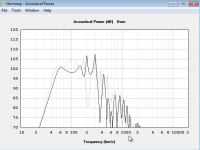
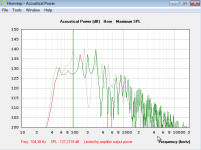
Here are two simple simulated comparisons between ROAR12 (grey line) and THAM12.
Spl at 2,0 Pi one watt (2,83 volts), and max spl based on 1300 watts and 10 mm xmax.
Most of the energy in the bass region is centered in the midbass around 80 Hz. The ROAR12 will have about 3 - 10 dB more output in that region compared to the THAM12.
One ROAR12 will match two THAM12 with ease - according to my experience. Then there are a whole lot of details not seen in a simple Hornresp comparison. The split path symmetrical loading of the driver, the plane loading of the driver diaphragm etc... Those details often do much more difference at real life high power levels usage then simple simulation graphs indicate.
The THAM12 does sound a little more "easy going" and joyful then the rather dark, serious and brutal ROAR12, but the ROAR12 does have a much more pronounced midbass attack and punch. I would personally prefer the THAM12 for indoor usage and the ROAR12 for outdoor usage. The ROAR12 does excite walls, windows, floors and everything that in any way can rattle and buzz, which is something to consider when choosing the design most appropriate for you.
I said it before, but Circlo what do you get if you extend the path beyond the tham fold?
A version of roar right?
Add 30cm to tham15 using detachable “barndoor” extensions and make the finishing area to full front area of the tham15. (Practical)
This will fill in the dip at ~150hz and also lower the tuning some.
A version of roar right?
Add 30cm to tham15 using detachable “barndoor” extensions and make the finishing area to full front area of the tham15. (Practical)
This will fill in the dip at ~150hz and also lower the tuning some.
In my experience it will shift all peaks and dips. It's a solution for more low end and in loudspeaker design that often means less output at the upper end of the band width (> 100 Hz in this case).Add 30cm to tham15 using detachable “barndoor” extensions and make the finishing area to full front area of the tham15. (Practical)
This will fill in the dip at ~150hz and also lower the tuning some.
If you want upper end from a TH I would design it for such from the start, of the top of my head, that would mean decreasing the stub before the horn throat and altering the throat area.
I thought it common knowledge that most energy is centered around 63 Hz, although I can't find a sourceMost of the energy in the bass region is centered in the midbass around 80 Hz
Johan
In my experience it will shift all peaks and dips. It's a solution for more low end and in loudspeaker design that often means less output at the upper end of the band width (> 100 Hz in this case).
If you want upper end from a TH I would design it for such from the start, of the top of my head, that would mean decreasing the stub before the horn throat and altering the throat area.
I agree, but this shift in dips in this case is quite favorable.
I have four tham15 with B&C 15PZB40 and of course I simulated before building them.
And using the original simulation input I get the solid black response. And by adding another segment 30cm long and ending area to 3400cm2 (the full front area of the original design).I get the light gray response with this mentioned “barndoor”
You have to go to my Flickr to see it.
Tham15 15PZB40 | malte Persson | Flickr
Last edited:
Thank you!
It’s a small barn where the first floor have been rebuild to a garage and a hobby-room.
And I stole the garage for my wood shop.
But the top floor is only for parties. Not that I have a lot of them. But it was for my wedding party I built this set of horns.
Untitled | malte Persson | Flickr
It’s a small barn where the first floor have been rebuild to a garage and a hobby-room.
And I stole the garage for my wood shop.
But the top floor is only for parties. Not that I have a lot of them. But it was for my wedding party I built this set of horns.
Untitled | malte Persson | Flickr
I agree, but this shift in dips in this case is quite favorable.
I have four tham15 with B&C 15PZB40 and of course I simulated before building them.
B&C 15PZB40 - 4" voice coil ? 700W? now replaced with 15PZB100?
Please tell me, in real life, how do you use them? what topers do you have? maybe some DSP settings....
is there any low end gaining when coupling multiple thams? please describe how do you use them? I dont have money to make multiple thams to test them togheter, that's why I ask all of this!
Thank you!
A quote from Bennet Prescott when he commented the build: “ These are almost the same as modern 15PZB100, a light cone woofer that can work in a sub.“
So yes!
I use them two parallel per channel with a Eq boost around 45hz I can’t remember Q and amount of boost, I did some eq on the out of band peak above 150hz to.
If you look at the impedance measurement, the bottom one are two in parallel as I intend to use them. The Impedance minimum don’t move lower in frequency but gets wider and isn’t this a indication that they don benefit as much as a undersized flh from multiples.
Tham15 15PZB40 | malte Persson | Flickr
And I have only done a really quick measurement and eq massage so far. So I have a hard time telling you anything helpful.
The tops are a commercial build around a B&C 8CX21 coaxial.
Not ideal to have them crossed as low as 120hz. I would like to minimize the cone excursion in the future with some 12” midbass unit I have laying around.
And in the future I plan to use the tham15 stacked on their side with the tops on top of that.
So yes!
I use them two parallel per channel with a Eq boost around 45hz I can’t remember Q and amount of boost, I did some eq on the out of band peak above 150hz to.
If you look at the impedance measurement, the bottom one are two in parallel as I intend to use them. The Impedance minimum don’t move lower in frequency but gets wider and isn’t this a indication that they don benefit as much as a undersized flh from multiples.
Tham15 15PZB40 | malte Persson | Flickr
And I have only done a really quick measurement and eq massage so far. So I have a hard time telling you anything helpful.
The tops are a commercial build around a B&C 8CX21 coaxial.
Not ideal to have them crossed as low as 120hz. I would like to minimize the cone excursion in the future with some 12” midbass unit I have laying around.
And in the future I plan to use the tham15 stacked on their side with the tops on top of that.
I agree, but this shift in dips in this case is quite favorable.
I have four tham15 with B&C 15PZB40 and of course I simulated before building them.
And using the original simulation input I get the solid black response. And by adding another segment 30cm long and ending area to 3400cm2 (the full front area of the original design).I get the light gray response with this mentioned “barndoor”
You have to go to my Flickr to see it.
Tham15 15PZB40 | malte Persson | Flickr
Wow! that’s a pretty easy add on yielding dramatic results!
I’ve been doing somethings with the ROAR, letting the layout get pretty agressive and then removing some of the mid band bump and upper bandwidth peaks with a very small absorber.
Geez, you keep raising the response
Who keeps raising the response?
I said it before, but Circlo what do you get if you extend the path beyond the tham fold?
A version of roar right?
Thank you NisseP!! This is a great idea! A very easy mod to existing THAM15 which seems to increase output substantially in the midbass.
I would not call that a ROAR design though. There are so many different parts that make up a ROAR design. We have only scratched the surface of the inner workings of a ROAR design in these forums.
Large plane wave resonators do add a whole new level of performance not easily seen in simulation programs.
I love your 4 X THAM build. Very nice looking THAM15 in baltic birch. I can guess that 4 X THAM15 in your barn produces plenty of quality bass with ease.
Have you built and tested your THAM15 plane wave resonator mod?
I rather use double tham12" than a single roar
The three simulations I posted in post 648 is the THAM12 with your specified Beyma driver.
The THAM12 seems to be one of the most built tapped horn designs out there. Very popular, and I do like them a lot.
They are very useful down to approximately 45 Hz despite the simulated apparent 60 Hz tuning. The simulated 60 Hz tuning does make them very "happy" sounding. Lots of punch and energy. A friend use a THAM12 for his bass guitar. He prefers the THAM12 with a B&C 12PS100 over many commercial bass amp and speaker combos.
- Home
- Loudspeakers
- Subwoofers
- THAM15 - a compact 15" tapped horn
